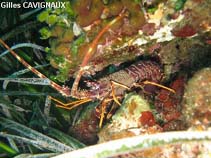Palinurus elephas (Fabricius, 1787)
Common spiny lobster| Native range | All suitable habitat | Point map | Year 2050 |

|
| This map was computer-generated and has not yet been reviewed. |
| Palinurus elephas AquaMaps Data sources: GBIF OBIS |
Classification / Names Common names | Synonyms | CoL | ITIS | WoRMS
Malacostraca | Decapoda | Palinuridae
Environment: milieu / climate zone / depth range / distribution range Ecology
Benthic; depth range 5 - 200 m (Ref. 85369), usually 10 - 70 m (Ref. 4). Subtropical; 12°C - 16°C (Ref. 114562), preferred 11°C (Ref. 107945); 61°N - 27°N, 32°W - 36°E (Ref. 114562)
Distribution Countries | FAO areas | Ecosystems | Occurrences | Introductions
Eastern Atlantic and the Mediterranean: from Norway to Morocco. Subtropical to temperate.
Length at first maturity / Size / Weight / Age
Maturity: Lm 10.0, range 7 - 8 cm Max length : 50.0 cm TL male/unsexed; (Ref. 441); common length : 40.0 cm BASL male/unsexed; (Ref. 441); max. reported age: 15 years (Ref. 85318)
Traditionally caught by traps, pots and sometimes by hand (e.g., diving and spearing; Refs. 441, 85369), but these gears were eventually replaced with trammel nets (Ref. 85369). Minimum depth from Ref. 4.
Life cycle and mating behavior Maturity | Reproduction | Spawning | Eggs | Fecundity | Larvae
Breeds once a year between June and October. Larger females mate and lay eggs earlier during breeding season while smaller females spawn towards the end (Ref. 85364).
Main reference
References | Coordinator | Collaborators
Holthuis, L.B. 1991. (Ref. 4)
IUCN Red List Status (Ref. 130435: Version 2024-1)
Vulnerable (VU) (A2bd); Date assessed: 26 September 2013
CITES status (Ref. 108899)
Not Evaluated
CMS (Ref. 116361)
Not Evaluated
Threat to humans
Human uses
Fisheries: commercial
FAO - Fisheries: landings | FishSource | Sea Around Us
Tools
More information
Trophic Ecology
Ecology
Population dynamics
Life cycle
Distribution
Human Related
Outreach
Taxonomy
References
Internet sources
BHL | BOLD Systems | CISTI | DiscoverLife | FAO(Fisheries: ; publication : search) | Fishipedia | GenBank (genome, nucleotide) | GloBI | Gomexsi | Google Books | Google Scholar | Google | PubMed | Tree of Life | Wikipedia (Go, Search) | Zoological Record
Estimates based on models
Preferred temperature
(Ref. 115969): 7.7 - 19.6, mean 11.9 (based on 808 cells).
Resilience
(Ref. 69278):
Medium, minimum population doubling time 1.4 - 4.4 years (K=0.13-0.21; tm=4; tmax=15).
Prior r = 0.22, 95% CL = 0.14 - 0.33, Based on 4 data-limited stock assessments.
Nutrients : Calcium = 109 [35, 184] mg/100g; Iron = 1.59 [1.21, 1.97] mg/100g; Protein = 20.2 [19.2, 21.3] %; Omega3 = 0.285 [0.185, 0.386] g/100g; Selenium = 48.3 [-31.7, 128.3] μg/100g; VitaminA = 0 μg/100g; Zinc = 1.79 [1.17, 2.40] mg/100g (wet weight); based on nutrient studies.



